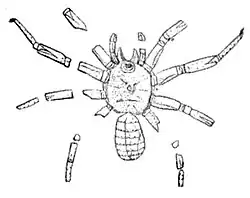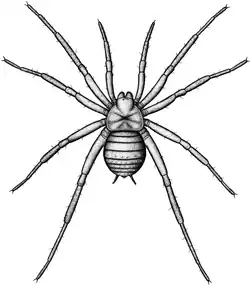Arthrolycosa
| Arthrolycosa Temporal range: Late Carboniferous to Late Permian
| |
|---|---|

| |
| Arthrolycosa antiqua, illustrated by C. E. Beecher | |

| |
| Reconstruction of Arthrolycosa wolterbeeki | |
| Scientific classification | |
| Kingdom: | Animalia |
| Phylum: | Arthropoda |
| Subphylum: | Chelicerata |
| Class: | Arachnida |
| Order: | Araneae (?) |
| Family: | †Arthrolycosidae |
| Genus: | † Harger, 1874 |
| Species | |
| |
Arthrolycosa (meaning wolf [spider] with joints) is an extinct genus of arachnids, possibly spiders, that lived about 300-250 million years ago.
Fossils have been found Mazon Creek USA, Piesberg in Germany and in the Kirov Oblast region, and the Kamensk-Shakhtinsky of Russia.[1][2][3][4]
A. antiqua is estimated to have a body length of about 2.17 cm[2] and may have preyed upon insects and other smaller animals that lived alongside them. A. wolterbeeki is the oldest spider known from Germany.[3]
External links & References
- ^ Selden, Paul A.; Shcherbakov, Dmitry E.; Dunlop, Jason A.; Eskov, Kirill Yu. (2014-09-01). "Arachnids from the Carboniferous of Russia and Ukraine, and the Permian of Kazakhstan". Paläontologische Zeitschrift. 88 (3): 297–307. Bibcode:2014PalZ...88..297S. doi:10.1007/s12542-013-0198-9. ISSN 1867-6812.
- ^ a b Selden, P. A. (2021). "New spiders (Araneae: Mesothelae), from the Carboniferous of New Mexico and England, and a review of Paleozoic Araneae". New Mexico Museum of Natural History and Science Bulletin. 84: 317–358.
- ^ a b Dunlop, Jason A. (2023-07-16). "The first Palaeozoic spider (Arachnida: Araneae) from Germany". PalZ. 97 (3): 497–504. Bibcode:2023PalZ...97..497D. doi:10.1007/s12542-023-00657-7. ISSN 1867-6812.
- ^ Selden, P. A.; Eskov, K. Y. (2005). "First record of spiders from the Permian period (Araneae: Mesothelae)". Bulletin of the British Arachnological Society. 13 (4): 111–116.